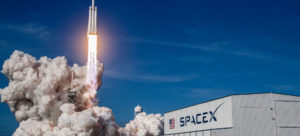
SpaceX Falcon Heavy Launch. (Photo: SpaceX).
When the SpaceX Falcon Heavy rocket took off from Cape Canaveral, Fla., last week, it carried CEO Elon Musk’s red Tesla Roadster into orbit to test heavier payloads.
While Musk’s other company, Tesla, is at the forefront of autonomous vehicle development, chances are the orbited car didn’t have LiDAR, or Light Detection and Ranging, sensors onboard.
Despite new capabilities, LiDAR continues to be a high-ticket item for companies and agencies testing autonomous vehicles. Velodyne’s venerable HDL-64, for instance, cost $80,000 per unit, according to published sources.
The cost and accuracy issues surrounding LiDAR may be one of the reasons such companies as Tesla aren’t using it. Some industry experts say that testers can achieve similar results by using cameras and inertial measurement units.
Musk, among others in the self-driving car space, has been a vocal critic of LiDAR. Musk, via Twitter, said LiDAR “is a crutch that will drive companies to a local maximum that will be hard to get out of…if you take the hard path…you achieve the global maximum. Perhaps I am wrong, in which case I will look like a fool, but I am quite certain I am not.”
The high cost of LiDAR has forced such companies as Velodyne to decrease unit prices in recent products. Other companies, like startup Innovusion, plan to roll out LiDAR units that will only cost a few hundred dollars in quantity.
The company, which likens its technology to the transition from text to graphical devices in the computer and smart industries, is targeting Level 4 and 5 of the autonomous vehicle and Advanced Driver Assistance Systems (ADAS) markets, said Junwei Bao, Innovusion CEO.
“Our engineers are naturally drawn to the toughest technical challenges and believe this is where we can have the most business and social [advanced driver assistance systems]. Image quality, high-definition LiDAR will also be useful in many other applications and adjacent markets,” he said. “Our products have great range, are cost effective and are available in very compact sizes a little bigger than an iPhone.”
Although autonomous vehicles are the company’s primary focus, Bao said that the product can be tailored for such applications as drones, geographic mapping, environmental resource management, logistics, security and defense. “I am sure our customers will surprise us by coming up with even more ways of using the technology and we look forward to watching the industry evolve,” he said.
Before starting Innovusion in 2016 with partner Yimin Li, Bao led the sensor and hardware team at Baidu’s Autonomous Business Unit. The company said its engineering team has an average of 15 years’ experience in the LiDAR industry.
“My original team is comprised of veterans in the precision instrument industry, key members from Velodyne, and some of my former colleagues in Baidu’s Autonomous Driving Business Unit. In addition, a few of my college classmates have joined,” he said. “We studied physics together during our undergraduate years–then spread out to different research areas post-graduation. Twenty years later, we have reunited to work together on this technology, each of us contributing in different areas [in] optics, software, firmware and algorithms.”
Field of LiDAR Companies Growing…
While cameras and other sensors are growing in importance, LiDAR is the recent champion of investors.
At least 50 LiDAR startups have gained $678.4 million in the last four years, according to CB Insights in a Los Angeles Times a recent article. More than half of the venture capital funds went to 18 companies in just 2017 alone, the article said.
With that much competition in the effort to get LiDAR down to $1,000 in quantity, Innovusion is trying to compare and differentiate itself.
“The primary difference between Innnovusion and Velodyne is that we have image quality, high-definition LiDAR,” Bao said. “Our resolution is over 300 lines. Most competitors in this field are less than100 lines. Mobileye uses camera data to derive 3D information, while our LiDAR provides reliable true 3D data through accurate measurement of time of flight of light.”
SpaceX Falcon Heavy May Revolutionize Launch Industry…
Ultimately, the recent SpaceX Falcon Heavy launch wasn’t about autonomous vehicles. It marked the first time a commercial company has ever sent up such a massive payload.
The successful launch not only put into low Earth orbit the largest payload, it did it at a price that could revolutionize the space industry, according to published reports.
The launch raises questions on how competitors United Launch Alliance and Arianespace will react. ULA, a joint venture between Boeing and Lockheed Martin, champions its Delta IV Heavy, which costs more than $400 million per launch. Musk contends that his Falcon Heavy costs $150 million per launch, according to published reports.
The Falcon Heavy is composed of three Falcon 9 boosters. The side boosters used in the February 6 launch were previously flown and recovered. According to published reports, several minutes after liftoff, they split off from the core and made their way back down to Cape Canaveral. Musk stated these boosters won’t be flown again.

